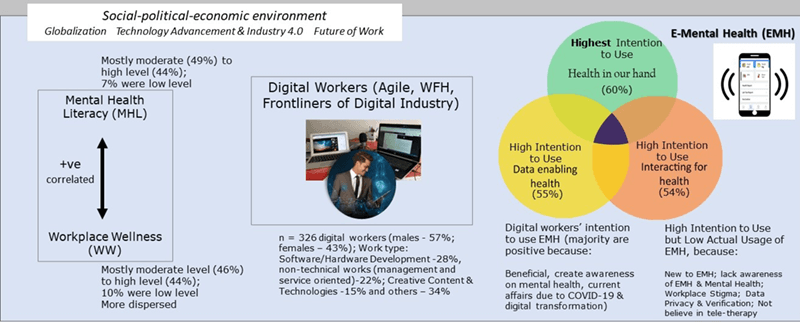 Open Access
Open Access
ARTICLE
Workplace Wellness, Mental Health Literacy, and Usage Intention of E-Mental Health amongst Digital Workers during the COVID-19 Pandemic
1
Faculty of Creative Multimedia, Multimedia University, Cyberjaya, 63000, Malaysia
2
Faculty of Applied Communication, Multimedia University, Cyberjaya, 63000, Malaysia
3
International Medical University (IMU), Bukit Jalil, 57000, Malaysia
* Corresponding Author: Ah-Choo Koo. Email:
International Journal of Mental Health Promotion 2023, 25(1), 99-126. https://doi.org/10.32604/ijmhp.2022.025004
Received 17 June 2022; Accepted 19 August 2022; Issue published 29 November 2022
Abstract
The prevalence of mental health problems in both Malaysian and global workplaces has significantly increased due to the presence of the coronavirus disease (COVID-19) pandemic, globalization, technology advancement in Industry 4.0, and other contributing factors. The pervasiveness of the issue poses a huge challenge to improving the occupational safety and health (OSH) of workers in various industries, especially in the digital industry. The emergence of the innovative industry is evident mainly due to the rapid development of Industry 4.0 and the relevant demands of multiple businesses in the digital transformation. Nonetheless, limited studies and academic discussions were conducted on the OSH topic of digital employees. Hence, the current study serves to fill the existing gap and provide academic contributions by scrutinising the perceptions of digital workers regarding their workplace well-being, mental health literacy, and the impression of employing e-mental health. The objectives of this study are: 1) To examine the mental health literacy and workplace wellness of digital workers, 2) to explore the emental health usage intention and actual e-mental health utilization, and 3) to identify digital workers’ feedback on e-mental health. In the current context, e-mental health focuses on three dimensions, namely, 1) “health in our hand (HIOH)”, 2) “interacting for health (IFH)”, and 3) “data enabling health (DEH)”. The present study employed an online cross-sectional survey and received 326 digital workers’ completed responses. Variables, such as “mental health literacy (MHL)”, “workplace wellness (WW)”, and e-mental health intention and usage were explicated by analysing the data through descriptive statistics. The study results indicated a moderate to a high level of the MHL and the WW. More than half of the workers possessed a high intention level to employ e-mental health, with the HIOH dimension being the most prevalent domain. Nevertheless, the actual e-mental health usage was very low, owing to the online resources being a new concept amongst digital employees. Numerous confounding factors also existed in affecting the low usage, such as privacy concerns, data security levels, and health verification issues. In addition, the mental health issue has not been openly and widely discussed in Malaysian workplaces due to stigmatisation. As such, the current findings could provide additional insights into the OSH literature; it could serve as a guideline for the OSH decision-makers, employers, and eHealth developers when establishing a feasible framework for the practical adoption of e-mental health services by digital workers.Graphic Abstract

Keywords
Cite This Article
 Copyright © 2023 The Author(s). Published by Tech Science Press.
Copyright © 2023 The Author(s). Published by Tech Science Press.This work is licensed under a Creative Commons Attribution 4.0 International License , which permits unrestricted use, distribution, and reproduction in any medium, provided the original work is properly cited.


 Submit a Paper
Submit a Paper Propose a Special lssue
Propose a Special lssue View Full Text
View Full Text Download PDF
Download PDF Downloads
Downloads
 Citation Tools
Citation Tools
